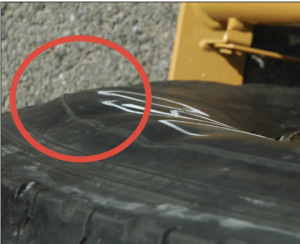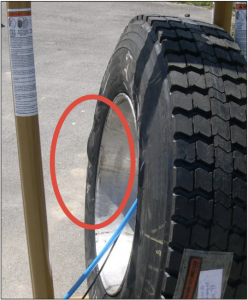Causes, risks, and how to prevent them.
Definition of sidewall tear:
Zipper ruptures (also known as sidewall tears) occur in the upper sidewall of the tire as it fails and “blows out” of the sidewall and appears like a large tear around 10-12 inches long typically but can be as large as three feet! The tear itself looks like a zipper with teeth alternating between the sides of the tear.
The tear has the teeth like appearance because there is a sudden transfer of load as the air pressure is evacuated which spreads from one point but evenly on the top and bottom of the initial location as it spreads horizontally. Only one side of the whole tire ever ruptures.
Causes of a zipper tear:
Loss of inflation pressure is the cause of a sidewall tear. Usually this is caused by a puncture but can also derive from a bent flange, cracked rim, leaky valve stem, or another issue causing the tire to lose air.
Risks of a sidewall tear:
Serious injury or death can be the result of being hit with the air that is released under pressure as a tire blows out. Anything in the way can be damaged as lighter items are moved like tools, the rim or tire can go flying and there is potential of hearing loss. That is why it is crucial and required by OSHA to use safety cages when inflating tires. Tires don’t have to be in the process of being inflated to have a zipper tear. This can happen at any time, as various stresses throughout use including inflation. Death can result from being impaled with an object or the concussion from the blast.
Prevention of zipper tears:
Inspecting your tires before trips or daily. With your inspections you will want to notice visual cues, tactile clues, and audio clues
- Visually inspect for:
- Punctures or other injuries
- Deformations like ripples and/or bulges in the sidewall
- Cuts, rips, or chips that expose cords or steel wire
- Touch your tires for:
- Soft spots in the sidewall flex or squishy areas
- Deformations like ripples and/or bulges above
- Extended wire from the tire indicating broken cords
- Listen for:
- Popping or crackling sounds


For information on best practices check out US tire Manufacturers Association (formerly RMA) or these resources:
- Tire Industry Association (TIA) – For training materials and other information visit tireindustry.Org
- USTMA wall charts regarding sidewall “zipper ruptures” and tire demounting/mounting procedures. Wall charts and other publications may be ordered online: USTires.org
- Technology and Maintenance Council of the American Trucking Associations, Inc.,
- Recommended Maintenance Practices and other publications. Available to order online: trucking.Org
- S. Department of Labor Occupational Safety and Health Administration Title 29 Code of Federal Regulations Ch. XVII Section 1910.177 Servicing multipiece and single piece rim/wheels. Available to view/download online: www.osha.gov/Publications/wheel/wheel-chart-booklet.pdf

